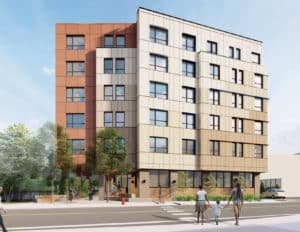
Designed by RODE Architects, the 52 New St. project in Cambridge’s Alewife neighborhood will include 106 units of family-oriented affordable housing developed by nonprofit Just-a-Start. Image courtesy of RODE Architects
Great design can transform lives, and as architects we have a responsibility for lifting all populations through the built landscape. One way to pursue this broader definition of inclusion is through thoughtfully designed urban multifamily properties – they have the ability to begin to act like a modern village, tapping into an inherent vibrancy and deeper ideas around sustainability.
New housing developments are drawing residents to New England cities, bringing new vitality and activity to urban centers while also sustaining an urban renaissance in the region. As the demand for more housing continues to surge, public agencies and private developers work to find new opportunities for growth. Resulting from this, entire new urban neighborhoods are sprouting up, bringing with them revitalized urban cores and peripheral neighborhoods, new retail and vibrant streetscapes.
But are they built for everyone? Can these new nodes of activity support a more holistic – and hopefully self-sustaining – social experience? If done correctly, it is possible.
Boston has the highest percentage of 25-to-34-year-old urban professionals of any major American city, as reflected by the fact that more than a third of rental units are occupied by this demographic. Urban professionals generally have a smaller household size, are able-bodied and have disposable income that feeds into the local economy and shapes the character of the streetscape.
Consequently, the bulk of new housing development caters to this group, with efficient unit layouts and integrated technology to support the emerging professional. Amenity spaces in new developments cater to trends defined by this cohort, and the ground floor retail reflects their purchasing habits.
Engineering a ‘Sense of Place’ in Multifamily Projects
Just as the segregating effect of outdated zoning bylaws cripple our ability to make mixed-use districts that enable the connections that form a community, so might the homogenous effect of current development trends undercut the need for cities to provide a comprehensive social experience: one that is accessible for all.
To ensure this does not happen, equity and access need to be at the forefront of design, with a focus on creating spaces that serve and support the needs of everyone who use them. With a shift in our focus and a realignment of priorities, development teams can contribute to a sense of place that is difficult to engineer, but essential to making a lasting place for living.
The solutions tend to compound their benefits. Connecting youth with seniors builds intergenerational trust and respect and addresses chronic isolation in seniors. The social and emotional development of youth benefits from a broad social net, which in turn builds a strong sense of community. Embracing diversity breaks invisible barriers and benefits disadvantaged groups, and can even lead to safer neighborhoods and improve food security.

Ben Wan
These adaptations may also find a timely partner in the evolving work week, as remote work increases pressure on the home to provide the same social supports that were once found in the office.
The site arrangement and amenity program play a key role in allowing this new community to flourish. Designing community rooms also with seniors and youth in mind can help activate these sometimes-underutilized amenities. Potentially bringing these rooms down to the street level will engage with the sidewalk and encourage ownership of the public realm; safe, protected outdoor space is a rarity and a challenge in urban environments. Consider a finish package that addresses sensory-sensitive issues, or adaptations for aging in place.
New developments are extending the fabric of our cities, but need to also provide a structure for the formation of a community. This is a kind of resiliency, one that will ensure the longevity of the spaces we create. We can make positive change with our projects, for the people who will live there, and for future populations.
Ben Wan is a principal at RODE Architects in Boston.




 |
| 
